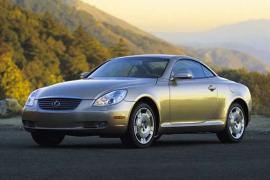
LEXUS SC
Generations Timeline, Specs and Pictures

Lexus introduced the second generation of the SC in 2000 at the New York Auto Show, and, unlike its predecessor, it was a coupe-cabriolet.
By 2005, the car was already old on the premium segment, and the carmaker introduced an updated version. Since Toyota sold it on three continents, including Europe, it had to comply with new emission regulations. The SC was unique in its class. Neither Mercedes-Benz, BMW, or Cadillac had a coupe-cabriolet.
Sotiris Kovos made the car’s design after he was inspired by yachts. The SC’s long hood and swept headlights were new, and so was the six-slat grille that sported the chromed Lexus badge. In the redesigned bumper, the carmaker installed new fog lights on the lower area, supported by a horizontal chromed bar.
Inside, Lexus introduced new colors and materials for the facelifted SC model. It provided a revised, three-dials instrument cluster with the speedometer in the middle. Strangely, the carmaker still offered a tape player for the luxurious vehicle. In fact, the SC was the last new car to provide a standard tape player on the U.S. market in 2010.
Under the hood, Toyota kept the same trustworthy 4.3-liter V-8 that provided 286 hp, paired with a six-speed automatic transmission, one more than the 2001 model. The car’s platform featured independent suspension in all corners, improving comfort.

While the first generation of the Lexus SC was a luxurious coupe, its predecessor was transformed into an elegant coupe-cabriolet to compete in the premium segment.
In 2001, Lexus decided to leave its competitors behind and offered a luxurious four-seat coupe-cabriolet. Neither Mercedes-Benz nor BMW had something like that on their offer. Finally, Lexus had something unique against its main rivals. Its shape was unusual for its class and showed a different approach to the premium segment. Lexus aimed at the younger, wealthy generation that didn’t want to go for the old brands’ conservative styling.
Its tear-shaped headlights and the reversed trapezoidal grille were typical for the SC series. Lexus’ designers tried to make an aerodynamic vehicle, and they succeeded. But it looked like they were not very concerned about how the coupe will look when it was closed; the car definitely looked better with the top down.
Toyota understood that most of the owners would drive with a companion and only occasionally with someone on the rear seats. The carmaker admitted that it was a 2+2 coupe-cabriolet and not a proper four-seat vehicle. While the front, thick and comfortable seats were cushioned and spoiled their occupants with an excellent level of comfort, there was little legroom left for the rear ones. Moreover, there was hardly any headroom left for anyone taller than a teenager with the car covered.
Under the hood, Lexus placed its bets on a 4.3-liter V-8 engine that offered 420 hp, which it sent to the rear wheels via a five-speed automatic transmission. Despite the car’s weight, it was surprisingly quick. But it was more of a premium GT than a fast roadster or coupe.

In 1991, Lexus introduced its first premium-coupe designed in the U.S. Its flowing lines and curvy appearance were right on the biodesign ascending trend.
The first generation of the SC Coupe was a hard gamble for the Lexus. While it was meant to be on the same market segment with the American luxury coupes of the ’90s, it ended up being more a competitor for the BMW 6-series (E24) and the E-Class Coupe (W124).
The car featured more unusual solutions for the exterior. For starters, it didn’t feature a grille for the radiator. To cool the engine, only the lower part of the bumper was used and that was a big challenge for the engineers. The dual headlights design, with the high-beam inside, was a different solution. Last, but not least, the doors were double-hinged to offer better access room for the rear passengers.
Inside the car featured the latest technologies for the stereo system. There was a cassette-player developed by Nakamichi and an on-board 6-CD changer. It was in 1991! The leather and wood trims formed a luxurious look and feel of the car.
Under the hood, the SC was available with a choice of good engines. One was the 3.0-liter and the top version was a hefty V8. Only the SC 300, with the 2JZ engine, was mated as standard to a 5-speed manual. The 4.0-liter eight-cylinder unit was mated to a 4-speed automatic.























































